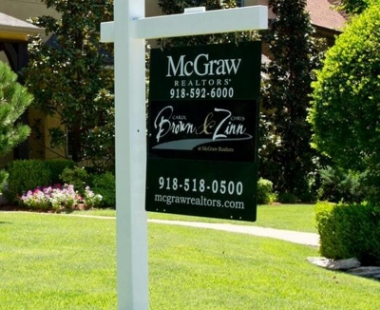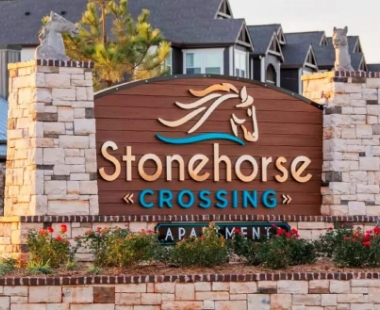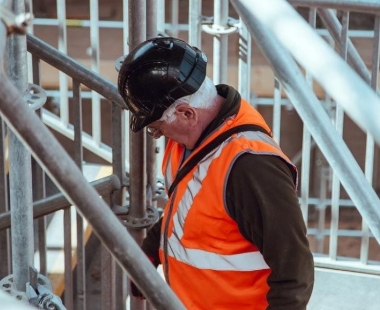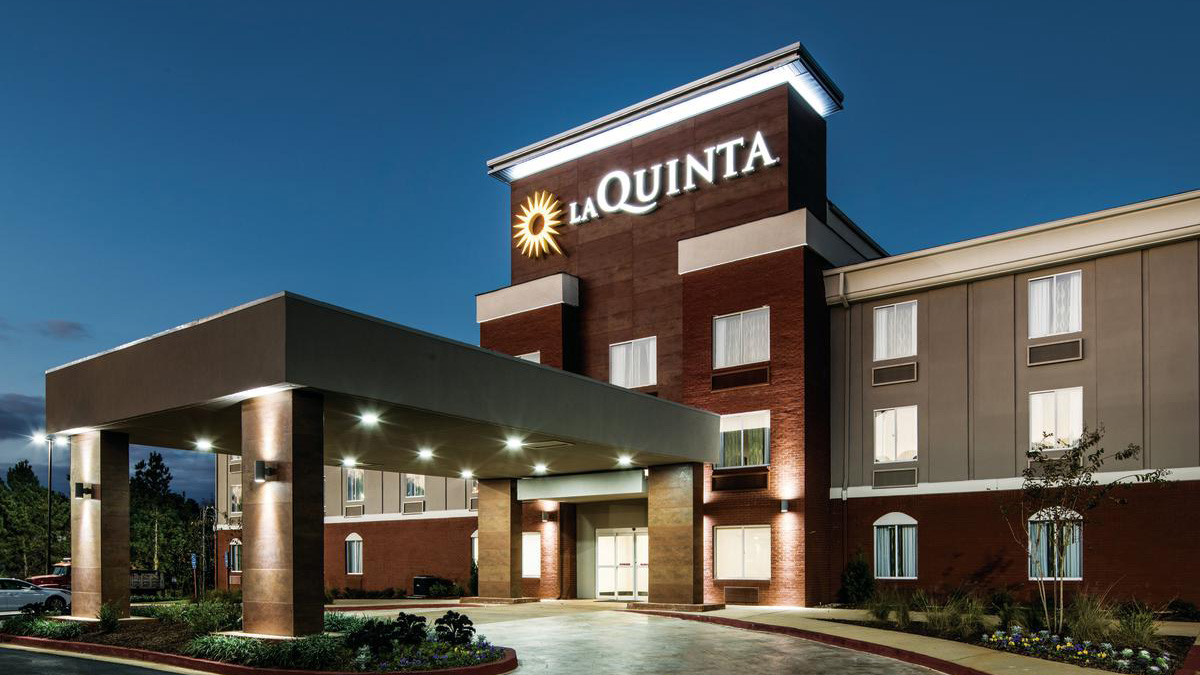

By Adonis Brewer
Manager of Business Development
Here's what we'll cover:
The hotel brands that have stood the test of time have all understood that delivering a consistent, personalized brand experience that’s finely tuned to meet the emotional needs of guests is the key to long-term success.
And while every aspect of visual branding plays a vital role in creating such a consistent experience, a hotel’s lighting plays an especially irreplaceable role in shaping and delivering every aspect of a guest’s stay with a hospitality brand.
However, rather than simply taking our word for it, let’s dive into the behavioral research and data that reveals how influential lighting is in a guest’s experience with a hotel and how it can benefit every aspect of your servicescape, positively influence your guests’ experiences, and save money.
How Does LED Lighting Benefit a Hotel’s Outdoor Branding and Exterior Spaces?
Though the majority of hotel bookings start with a fair bit of online research, a major portion of the first impression your brand makes on a guest is through your building itself, your outdoor branding, and the exterior spaces that welcome new and returning guests alike.
Architectural LED lighting helps your hotel stand out and helps guests find you from the street.
Your hotel’s visibility — especially at night — is often one of the most important aspects of the first impression you create. To your travel-weary guest, your hotel is the oasis they’ve been looking forward to for hours or even days.
But if your building is almost impossible to spot from the street, that’s strike one to most guests, and sets up a major red flag in their mind that makes them anticipate an all-around poor experience.
Here, vivid LED lighting helps your building’s architecture not only stand out from your competition, but it also ensures your guests get off on the right foot with your brand by providing them an easy way to quickly identify and get to your location.

Leon®: Our go-anywhere,
do-anything rigid LED
- Long life: 50k-70k hours
- 85% more energy efficient than neon
- Seamless color, no sags, no light gaps
Illuminated landscapes and walkways provide easy outdoor wayfinding and help reduce accidents.
Landscaping and the quality of your wayfinding play major roles in how your hotel is received by the community you serve and plays a powerful role in shaping how guests perceive the overall quality of your brand.
After all, how much trust would you place in a hotel that has poor landscaping and unlit uneven walkways that are difficult to navigate?
If you’re like most people — and like your guests — not very much at all.
In fact, the rate of repeat guest booking is strongly correlated to the overall presentational quality of a hotel’s outdoor spaces, especially when it comes to how well-lit those spaces are at night and during hours of low visibility.
Additionally, outdoor slips and falls due to poor lighting are among some of the most common injuries suffered by guests. And more often than not, these lawsuits spell costly settlements for hospitality brands.
Vivid architectural lighting makes your hotel guests feel safe, welcomed, and that your hospitality brand is of high quality.
While your hotel’s architectural lighting naturally affects how easily your guests can find your hotel, it also has a profound impact on how your guests perceive the overall quality of their stay and of your hospitality brand as a whole.
And at the root of these perceptions are the built-in associations the human brain has with light, safety, and security.
In turn, when we encounter bright lighting on an outdoor structure, the brain naturally interprets that structure as a place that’s safe and welcoming.
When your guests’ first association with your hotel is one of feeling welcome and secure, they feel a higher sense of satisfaction with their stay, and you’re well on your way to ensuring their overall perception of your brand is stellar.
How Does LED Lighting Benefit a Hotel’s Indoor Branding & Interior Spaces?
With your outdoor lighting laying the groundwork for how your guests perceive your location, your staff, and the overall quality of their experience, it’s your interior spaces — and the lighting experiences you create within them — that are inextricably tied to their lasting opinion of your brand.
Lighting architects and designers can create welcoming atriums, entrances, and foyers.
After finding their way to your hotel’s location, your hotel’s main entrance is where your guests truly experience the first glimpse of what your brand has to offer them.
However, this is unfortunately where many hotel brands fall short by treating their lighting as an afterthought without considering the role it plays in making that all-important first impression with guests.
Whether you’re aiming to create a warm atmosphere that welcomes road-weary travelers into a much-deserved place of rest and comfort, or you’re looking to instill a spirit of action and excitement, LED lighting equips your team with unparalleled design capability and flexibility.
More importantly, modern hotel LED lighting allows you, your brand’s lighting architects, or interior designers to hone in on the most important aspect of hotel entryway lighting: color.
According to a joint study on hotel entrance lighting from Brigham Young University and Purdue, the color of lighting within a hotel’s entrance and entryways was the biggest factor in reinforcing a desired emotional response within guests as they entered the building.

LumiFlex™: Side-to-side
Bending LED
- Easy to manipulate
- 85% more energy efficient than neon
- Perfect replacement for neon
LED lighting gives you full control over the guest experience in your hotel’s restaurants and dining areas.
It’s no secret that lighting plays a huge role in how your customers perceive your restaurants and food service spaces.
If your lighting is low-quality, spotty, or inconsistent, you can safely bet this will translate into your guests feeling as if they received sub-standard food and below-average service.
But if it’s in alignment with the positive emotional landscape your brand aims to provide for customers throughout their dining experience, you’re in a strong position for both your hotel’s restaurant and its food to be well-received and highly rated.
While lighting’s effect in the area of hotel foodservice has been well-known for some time, the need for brands to capitalize on that opportunity for improved brand perception has never been more urgent.
According to foodservice industry research giant Technomic, two of the most important factors they forecast for hotel foodservice brands in 2020 and beyond are food color and brand sustainability.
Concerning food color, guests are placing an ever-greater level of importance on the freshness and quality of the whole grains and organic produce that they enjoy.
And for these modern guests, color is not only an aesthetic element that they value, but also their most trusted indicator of quality, freshness, and nutrition.
Should the colors not match guests’ expectations, regardless of whether it’s due to the food itself or the lighting in the restaurant, the restaurant’s brand image takes a hit, as modern diners are quick to share their first impressions of food and overall brand quality on social media and third-party review sites.
And perhaps more important to modern diners is the restaurant’s overall sustainability, be it with regard to the food they enjoy or the carbon footprint of the hotels they choose for their travels.
Here, on this dual fronts of guest dining expectations, LED lighting offers an eloquent solution that both meets the needs of your guests while helping you reduce fixed costs and energy consumption.
Through the robust programmatic controls they offer, your hotel restaurant’s LED lighting solutions can create the perfect blend of brightness and hues to match the emotional tone of your brand while simultaneously enhancing the presentation and perceived quality of your food.
Combined, these influences have a profound effect on the average dollar amount spent per guest and increases the likelihood of return visits to your restaurant.
Your hotel’s gyms, pools, and activity areas feel more energetic, spur activity, and promote safety.
Amenities such as gyms and pools are a big value-add for hotels and are especially effective at attracting frequent travelers who need a way to stay fit and active while on the go.
However, much like in every other space within your hotel, if the lighting’s not in congruence with your brand’s emotional servicescape or if it doesn’t match the purpose of the space, it’s going to severely degrade your guests’ perception of their stay.
To best understand how to light these spaces effectively, it’s important we understand what your more active guests consider important in these spaces.
According to a 2019 study of frequent gym goers, here were 6 key elements that elevated their perceived quality of an activity-focused space and the quality of the workout they achieved:
-
- Security, both in accessing the space and the throughout the space itself
- Bright lighting that kept them alert and motivated
- Large, uninterrupted spaces
- Environmental friendliness of the space itself
- High-energy music to keep their mood elevated
- Other people in the space
As you can see, your hotel’s gym lighting plays a huge role in how receptive your guests are to the space and how they feel when using it.
By leveraging an LED lighting solution for your hotel’s gym, pool, or other activity area, you don’t just simply meet your guests’ need to feel safe, motivated, and alert.
You show them that your brand goes the extra mile and is dedicated to being an environmentally-conscious brand that, like them, puts sustainability at the forefront of every decision your hotel makes.
And through meeting these needs, and demonstrating your environmental conscientiousness, you create a workout environment that provides your guests with their ideal space while also increasing the likelihood of them leaving great online reviews and booking future stays.
LED lighting imbues your hotel’s meeting rooms and conference halls with a productive and creative atmosphere.
As organizations across the globe continue to strive to reduce their carbon footprint and provide more eco-friendly workplaces, the data linking bright lighting, productivity, and overall cognitive performance continues to grow stronger.
And it’s here that LED lighting allows you to have a direct impact on a strong sector of your repeat guests: business travelers.
By outfitting your conference halls, private meeting areas, and even the desks within your guests’ rooms with vivid lighting, you’re creating the high-productivity spaces that they’ll be drawn to time and again, as they know that’s a space where they can reliably focus and get meaningful work done.
Your guests’ rooms feel cleaner, safer, and more restful.
Of all of the benefits of hotel LED lighting that we’ve covered, one of the most impactful — if not the most directly impactful — applications is the lighting within your guests’ rooms.
It’s here that guests desire the most immediate control over their lighting environment.
While some may want a warm, cozy, and inviting lighting experience, others might pine for a highly-illuminated, maximum-productivity environment where they can get things done without interruption.
Unfortunately, it’s also here that many hospitality brands fall short when it comes to their in-room hotel lighting, as poor lighting is among the most often-cited reasons as to why guests weren’t happy with their rooms.
And if your guests aren’t happy with their rooms, they’re simply not going to be happy with their stay or your brand as a whole.
Thankfully, highly-customizable LED lighting solutions empower you to create the exact emotional tone your brand desires or, through dimmers and similar controls, can allow your guests to create the environment that best suits their needs.
These consistently positive brand experiences, coupled with clean, well-lit rooms that align with both your branding and the needs of your customers is what consistently drives repeat bookings and wins long-term loyalty.
From design to execution, we work with you every step of the way to find the best solution for you and your guests.
I want to deliver my guests a superior experienceHow Does LED Lighting Benefit a Hotel’s Staff?
The benefits that LED lighting offers your hotel and its guests make the investment extremely worthwhile on its own.
However, what’s often left unconsidered is the immense benefits that your hotel’s LED lighting has on your staff, their performance, and overall workplace safety.
Your hotel’s staff is more alert and attentive, reducing costly mistakes.
In the same manner that LED lighting has a profound effect on your guests’ productivity in your hotel’s meeting spaces and conference rooms, so too does it play a role in bolstering the productivity of your staff.
In addition to productivity, however, are the profound benefits that cool white lighting (6000k) has on increasing visual processing speed and visual reaction times — often up to 15% or more.
In a day-to-day application, this directly translates into a workforce that’s more attentive, alert, and able to catch mistakes that could prove costly to both you and your hotel’s reputation.
LED lighting helps reduce slips, falls, and other costly injuries.
Just as guest safety is always top-of-mind for any hotel brand, so too is concern for staff safety as they care for guests and keeping the hotel humming.
By leveraging the ability of LED lighting to help ensure high visibility and equip a workforce to be more attentive and alert, you greatly curb the risk of accidents and injuries in the workplace.
In turn, this also helps you safeguard yourself and your brand from costly workman’s compensation lawsuits and helps you ensure you’re getting the utmost from the team you trust to care for your guests.
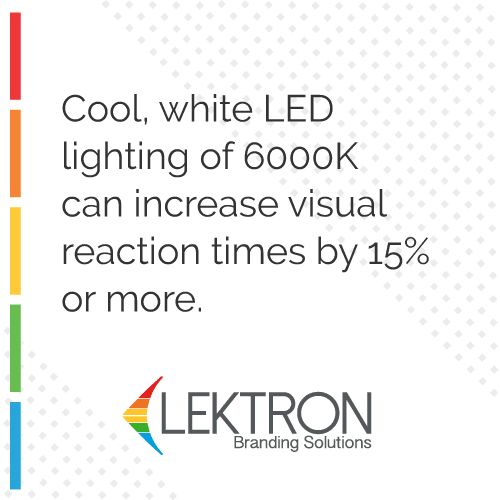
How Does LED Lighting Impact a Hotel’s Operational Costs?
Whether you’re aiming to retrofit your hotel with LED lighting or you’re a franchisee with a major hospitality brand that’s looking to outfit a new location with modern lighting solutions, we always want to help you stay on top of costs.
Though LED lighting might be more expensive upfront for a hotel brand, there are both immediate and long-term savings that make LED the clear choice versus more outdated solutions.
- You immediately reduce your monthly energy costs
- You significantly and permanently cut your total energy usage
- You save time and money on regular lighting maintenance
Working with Your Hospitality Brand to Create Long-lasting Success
We’re fortunate to work with some of the largest hospitality brands across North America in helping them amplify their visual branding and win more repeat bookings.
If there’s a good time for you and your schedule, we’d love to have the opportunity to speak with you about your business goals and how we might work together to help you attract more guests and provide them with a superior experience that transforms them into brand advocates.
Let’s work together to attract more guests and improve your bottom line.
Work With Lektron
About Adonis Brewer
Adonis Brewer, Manager of Business Development at Lektron Branding Solutions, connects businesses of all sizes throughout North America reach more customers through turnkey LED, product identification, and signage solutions that attract more customers and increase revenue.
References
- Bommel, Wout van. “Dynamic Lighting at Work–Both in Level and Colour.” 2006.
- Chung, Lai Hong, and Lee D. Parker. “Managing Social and Environmental Action and Accountability in the Hospitality Industry: A Singapore Perspective.” Accounting Forum, vol. 34, no. 1, 2010, pp. 46–53., doi:10.1016/j.accfor.2009.10.003.
- Ciani, Amy Elizabeth. “A Study of How Lighting Can Affect a Guests Dining Experience.” doi:10.31274/etd-180810-1649.
- Countryman, Cary C., and Soocheong Jang. “The Effects of Atmospheric Elements on Customer Impression: the Case of Hotel Lobbies.” International Journal of Contemporary Hospitality Management, vol. 18, no. 7, 2006, pp. 534–545., doi:10.1108/09596110610702968.
- Dev, Chekitan S., and Glenn Withiam. “Branding Hospitality: Challenges, Opportunities and Best Practices.” Cornell Hospitality Roundtable Proceedings, vol. 4, no. 5, 2012, pp. 6–14.
- Emir, Oktay. “Customer Complaints and Complaint Behaviours in Turkish Hotel Restaurants: An Application in Lara and Kundu Areas of Antalya.” African Journal of Business Management , vol. 5, no. 11, 4 June 2011, pp. 4239–4253.
- Garber, Lawrence L., et al. “The Effects of Food Color on Perceived Flavor: A Factorial Investigation in India.” Journal of Food Products Marketing, vol. 22, no. 8, 2015, pp. 930–948., doi:10.1080/10454446.2014.885864.
- Heerwagen, Judith. “Green Buildings, Organizational Success and Occupant Productivity.” Building Research & Information, vol. 28, no. 5-6, 2000, pp. 353–367., doi:10.1080/096132100418500.
- Huang, Kuo-Tsang, et al. “Analysis and Benchmarking of Greenhouse Gas Emissions of Luxury Hotels.” International Journal of Hospitality Management, vol. 51, 2015, pp. 56–66., doi:10.1016/j.ijhm.2015.08.014.
- Jones, Peter, Hillier, David and Comfort, Daphne (2014) “Sustainability in the global hotel industry.” International Journal of Contemporary Hospitality Management, vol. 26 (1). pp. 517. ISSN 09596119
- Mihaela-Simona, Apostol. “Hotel Lighting Systems in the Context of Global Energy Crisis – An Approach in Perspective of Sustainable Development.” International Journal of Academic Research in Accounting, Finance and Management Sciences, vol. 2, no. 1, 2012, pp. 204–210.
- Oberfeld, Daniel, et al. “Ambient Lighting Modifies The Flavor Of Wine.” Journal of Sensory Studies, vol. 24, no. 6, 2009, pp. 797–832., doi:10.1111/j.1745-459x.2009.00239.x.
- Oleskow-Szlapka, Joanna, et al. “Pro-Ecological Solutions Applied in Hotels: Examples.” Information Technologies in Environmental Engineering Environmental Science and Engineering, 2011, pp. 431–444., doi:10.1007/978-3-642-19536-5_34.
- Pennisi, Lisa A. “Greening The Hospitality Industry.” Nebraska Extension Publications – NebGuide, 27 July 2010.
- Scherzer, Teresa, et al. “Work-Related Pain and Injury and Barriers to Workers’ Compensation Among Las Vegas Hotel Room Cleaners.” American Journal of Public Health, vol. 95, no. 3, 2005, pp. 483–488., doi:10.2105/ajph.2003.033266.
- Shantha, A Aruna. “‘The Impact of Interior and Exterior Designs of Hotels on Customer Perception: The Sri Lankan Experience.’” Advances in Business, Hospitality, and Tourism Research, vol. 7, 2018, p. 109., doi:10.5038/9781732127524.
- Siguaw, J, and C Enz. “Best Practices in Hotel Operations.” The Cornell Hotel and Restaurant Administration Quarterly, vol. 40, no. 6, 1999, pp. 42–53., doi:10.1016/s0010-8804(00)87464-9.
- Sparks, Beverley A., and Victoria Browning. “The Impact of Online Reviews on Hotel Booking Intentions and Perception of Trust.” Tourism Management, vol. 32, no. 6, 2011, pp. 1310–1323., doi:10.1016/j.tourman.2010.12.011.
- Usta, Murat, et al. “The Impact of Hotel Attributes’ Satisfaction on Overall Guest Satisfaction.”
- Valdez, Patricia, and Albert Mehrabian. “Effects of Color on Emotions.” Journal of Experimental Psychology, vol. 123, no. 4, July 1994, pp. 394–409.
- Wardono, Prabu, et al. “Effects of Interior Colors, Lighting and Decors on Perceived Sociability, Emotion and Behavior Related to Social Dining.” Procedia – Social and Behavioral Sciences, vol. 38, 2012, pp. 362–372., doi:10.1016/j.sbspro.2012.03.358.

